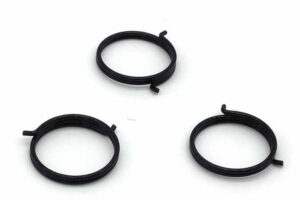Torsion Spring Design: Principles, Considerations, and Best Practices

Torsion springs are mechanical components widely used in various industries, offering the ability to store and release rotational energy. These springs play a critical role in systems that require rotational motion, providing torque, balance, and control. A well-designed torsion spring ensures optimal performance, longevity, and safety. In this article, we will explore the principles, considerations, and best practices for torsion spring design.
Principles of Torsion Spring Design:
1. Load and Torque Requirements:
Properly understanding the load and torque requirements is fundamental to torsion spring design. It involves determining the applied force and the desired angular deflection to accurately calculate the required torque and the spring’s dimensions.
2. Material Selection:
Selecting the appropriate material is vital to ensure the torsion spring meets the application’s demands. Factors such as strength, fatigue resistance, temperature range, corrosion resistance, and cost must be considered when choosing materials like high-carbon steels, stainless steels, alloy steels, or non-ferrous alloys.
3. Wire Diameter and Coil Diameter:
The wire diameter, along with the coil diameter, determines the spring’s flexibility, strength, and stress distribution. Optimal wire diameter selection involves considering the available space, required torque, and stress limitations.
4. Leg Length:
The leg length affects the angular deflection and mechanical advantage of the torsion spring. Longer legs provide higher torque output, while shorter legs offer increased angular deflection. Balancing leg length with space limitations and torque requirements is crucial.
5. End Types and Configurations:
Various end types, such as straight, bent, or hooks, allow for different modes of attachment and ease of installation. The choice of end configuration must consider compatibility with mating parts and overall system requirements.
Considerations for Torsion Spring Design:
1. Stress Analysis and Fatigue Life:
Accurate stress analysis helps evaluate the spring’s performance and longevity. Careful consideration of factors such as stress concentration, residual stress, and fatigue life estimation enables the design of a reliable and durable torsion spring.
2. Spring Rate and Angular Deflection:
Calculating the spring rate and angular deflection helps optimize the spring’s behavior under load. This ensures that the torsion spring will meet the required torque and angular displacement specifications.
3. Space Limitations:
Torsion springs are often designed within limited spaces. It is essential to carefully consider the available space, including radial and axial clearances, to accommodate the desired torsion spring dimensions.
4. Surface Treatment and Coatings:
Applying appropriate surface treatments like stress relief, shot peening, or coatings enhances the spring’s fatigue life, corrosion resistance, and performance in demanding environments.
Best Practices for Torsion Spring Design:
1. Design Validation and Prototyping:
Preliminary design validation using computer-aided simulations, finite element analysis, or prototyping helps ensure the torsion spring’s functionality and performance before full-scale production.
2. Quality Control and Testing:
Establishing stringent quality control measures, including dimensional inspections, load testing, and stress analysis, guarantees that torsion springs meet the required specifications and adhere to industry standards.
3. Design for Manufacturability:
Engaging with the manufacturer early in the design process allows for optimized manufacturability, cost-effectiveness, and improved overall performance. Collaborating with experts ensures the design can be efficiently translated into a reliable and efficient torsion spring.
Conclusion:
Torsion spring design demands meticulous attention to detail, considering load requirements, material selection, dimensions, and attachment methods. Adhering to the principles, considerations, and best practices outlined in this article will result in a robust and efficient torsion spring design. By ensuring optimal performance, reliability, and longevity, well-designed torsion springs play a vital role in a wide range of applications across numerous industries.






